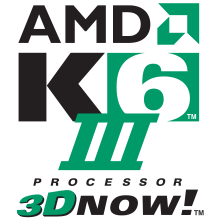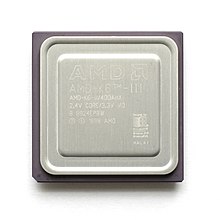AMD K6-III
This article is written like a personal reflection, personal essay, or argumentative essay that states a Wikipedia editor's personal feelings or presents an original argument about a topic. (December 2007) |
 | |
| General information | |
|---|---|
| Launched | February 1999 |
| Discontinued | 2000 |
| Common manufacturer | |
| Performance | |
| Max. CPU clock rate | 350 MHz to 550 MHz |
| FSB speeds | 66 MHz to 100 MHz |
| Architecture and classification | |
| Technology node | 0.25µm to 0.18µm |
| Microarchitecture | x86 |
| Instruction set | MMX, 3DNow!, Enhanced 3DNow! (K6-III+) |
| Physical specifications | |
| Cores |
|
| Sockets | |
| Products, models, variants | |
| Core name |
|
| History | |
| Predecessor | K6-2 |
| Successor | K7 |
The K6-III, code-named "Sharptooth", was an x86 microprocessor manufactured by AMD, released on 22 February 1999, with 400 and 450 MHz models. It was the last Socket 7 desktop processor. For an extremely short time after its release, the fastest available desktop processor from Intel was the Pentium II 450 MHz. However, the K6-III also competed against the Pentium III "Katmai" line, released just days later on February 26. "Katmai" CPUs reached speeds of 500 MHz, slightly faster than the K6-III 450 MHz. K6-III performance was significantly improved over the K6-2 due to the addition of an on-die L2 cache running at full clock speed. When equipped with a 1MB L3 cache (on the motherboard) the 400 and 450 MHz K6-IIIs is claimed by Ars Technica to often outperform[1] the hugely higher-priced Pentium III "Katmai" 450- and 500-MHz models, respectively.
Architecture

In conception, the design is simple: it was a K6-2 with on-die L2 cache. In execution, however, the design was not simple; with 21.4 million transistors. The pipeline was short compared to that of the Pentium III and thus the design did not scale well past 500 MHz. Nevertheless, the K6-III 400 sold well, and the AMD K6-III 450 was clearly the fastest x86 chip on the market on introduction, comfortably outperforming AMD K6-2s and Intel Pentium IIs.[citation needed]
3DNow!
A single instruction multiple data (SIMD) operations by a packed single-precision floating-point data format. It was an enhancement to the MMX instruction set, which contained 21 new instructions that support SIMD floating-point operations and includes SIMD integer operations, data prefetch, and faster MMX-to-floating-point switching. The K6-III+ had the "Enhanced 3DNow!"(Extended 3DNow! or 3DNow+) which added 5 new DSP instructions, but not the 19 new extended MMX instructions.
TriLevel Cache
The original K6-2 had a 64 KB primary cache and a much larger amount of motherboard-mounted cache (usually 512 KB or 1024 KB but varying depending on the choice of motherboard). The K6-III, with its 256 KB on-die secondary cache, re-purposed the variable-size external cache on the motherboard as the L3 cache. This scheme was termed "TriLevel Cache" by AMD. The L3 cache has a capacity of up to 2 MB.
Market performance
Intel's Pentium II replacement was not yet available but, as a stop-gap, Intel introduced a modestly revised version of the Pentium II and re-badged it as the "Pentium III". The base design was unchanged (the addition of SSE instructions was at that time of no performance significance) but Intel's new production process allowed clockspeed improvements, and it became difficult to determine which company's part was the faster. Most industry observers[who?] regarded the Intel part as superior for floating-point intensive tasks (such as most 3D games), but the K6-III as better for mainstream integer work.
Both firms were keen to establish a clear lead, and both experienced manufacturing problems with their higher-frequency parts. AMD chose not to sell a 500 MHz or faster K6-III after the rare 500 MHz K6-III had been immediately recalled; it was found to be drawing enough current to damage some motherboards. AMD preferred to concentrate on their soon-to-be-released Athlon instead. Intel produced a 550 MHz Pentium III with some success but their 600 MHz version had reliability issues and was soon recalled.
With the release of the Athlon, the K6-III became something of an orphan. No longer a competitive CPU in its intended market segment, it nevertheless required substantial manufacturing resources to produce: in spite of its 21.4 million transistors, its 118 mm² die was considerably smaller than the 184 mm² of the 22-million-transistor Athlon (cache RAM taking much less area per-transistor than logic), but the K6-III was still significantly more costly to produce than the 81 mm² 9.3 million-transistor K6-2 CPUs. (roughly 2/3 the size of the K6-III) For a time, the K6-III was a low priority part for AMD—something to be made only when all orders for high-priced Athlons and cheap-to-produce K6-2s had been filled—and it became difficult to obtain in significant quantities.
The original K6-III went out of production when Intel released their "Coppermine" Pentium III (a much improved part that used an on-die cache) and, at the same time, switched to a new production process. The changeover was fraught with difficulties and Intel CPUs were in global short supply for 12 months or more. This, coupled with the better performance of the Athlon, resulted in even many former Intel-only manufacturers ordering Athlon parts, and stretched AMD's manufacturing facilities to the limit. In consequence, AMD stopped making the K6-III in order to leave more room to manufacture Athlons (and K6-2s).
K6-III+ and K6-2+
By the time the x86 CPU shortage was over, AMD had developed revised versions of the K6 family: the K6-2+ and the K6-III+. Essentially, both parts were K6-IIIs (the 2+ with a 128 KiB cache, the III+ with the full 256 KiB) made on a new 180 nm production process. The K6-2+ and K6-III+ were specifically designed as low-power mobile CPUs, therefore they were the first processors to be available with the PowerNow! power saving technology. Essentially, the power savings were achieved with a combination of frequency (through adjusting multipliers) and voltage reduction.
Although targeted at notebook computers, both parts were also used by enthusiasts in desktop systems. AMD continued to devote their marketing resources to the Athlon and neither part became well-known outside the industry, but both had modest success and became firm favourites with the overclocking community. K6-III+ 450 MHz CPUs routinely overclocked to almost 600 MHz. Unfortunately, even with the 180 nm process, the K6 architecture's short 6-stage pipeline was stretched to the limit with regards to clock speed ramping. While the new "Coppermine" Pentium III was able to rise up to a final 1.13 GHz clock speed, K6 III+ and 2+ never clocked higher than 570 MHz officially, with overclockers using air cooling achieving around 800 MHz at best.
Models
K6-III ("Sharptooth", K6-3D+, 250 nm)

- CPU ID: AuthenticAMD Family 5 Model 9
- L1-Cache: 32 + 32 KiB (Data + Instructions)
- L2-Cache: 256 KiB, fullspeed
- MMX, 3DNow!
- Socket 7, Super7
- Front side bus: 66/100, 100 MHz
- VCore: 2.2 V, 2.4 V
- First release: February 22, 1999
- Manufacturing process: 0.25 µm
- Clockrate: 400, 450 MHz
K6-III-P (250 nm, mobile)
- CPU ID: AuthenticAMD Family 5 Model 9
- L1-Cache: 32 + 32 KiB (Data + Instructions)
- L2-Cache: 256 KiB, fullspeed
- MMX, 3DNow!
- Socket 7, Super7
- Front side bus: 66, 95, 96.2, 66/100, 100 MHz
- VCore: 2.0 V, 2.2 V
- First release: May 31, 1999
- Manufacturing process: 0.25 µm
- Clockrate: 350, 366, 380, 400, 433, 450 MHz
K6-2+ (180 nm, mobile)

- CPU ID: AuthenticAMD Family 5 Model 13
- L1-Cache: 32 + 32 KiB (Data + Instructions)
- L2-Cache: 128 KiB, fullspeed
- MMX, Extended 3DNow!, PowerNow!
- Super Socket 7
- Front side bus: 95, 97, 100 MHz
- VCore: 2.0 V
- First release: April 18, 2000
- Manufacturing process: 0.18 µm
- Clockrate: 450, 475, 500, 533, 550 MHz. (570 MHz, undocumented)
K6-III+ (180 nm, mobile)

- CPU ID: AuthenticAMD Family 5 Model 13
- L1-Cache: 32 + 32 KiB (Data + Instructions)
- L2-Cache: 256 KiB, fullspeed
- MMX, Extended 3DNow!, PowerNow!
- Super7
- Front side bus: 95, 100 MHz
- VCore: 2.0 V, (1.6 V, 1.8 V low voltage types)
- First release: April 18, 2000
- Manufacturing process: 0.18 µm
- Clockrate: 400, 450, 475, 500 MHz. (550 MHz, undocumented)
References
External links
- AMD-K6-III Processor AMD (archived)
- AMD K6-III-P Mobile Product Brief AMD (archived)
- AMD K6-III+ Mobile Product Brief AMD (archived)
- IA-32 implementation: AMD K6 (K6, K6-2, and K6-III) at sandpile.org
- Socket 7: Fit For Years To Come! at Tom's Hardware
- Recipe For Revival: K6-2+ at AcesHardware.Com
- K6-III+: Super-7 to the Limit at AcesHardware.Com
- CPU Upgrade: Getting the AMD K6-2+ / K6-III+ to work on your Super Socket 7 board
- K6Plus.Com Overclockers Database
- Overclockers.Com CPU Database
- Pictures of AMD-K6-III chips at CPUShack.com
- Technical overview of the AMD-K6 series
- www.k6plus.com Enthusiasts which work even nowadays with K6-x+
- Central Tweaking Unit by Rob Mueller, allows use of Framebuffer (MTTR)& Write-Combining for K6-x CPUs
